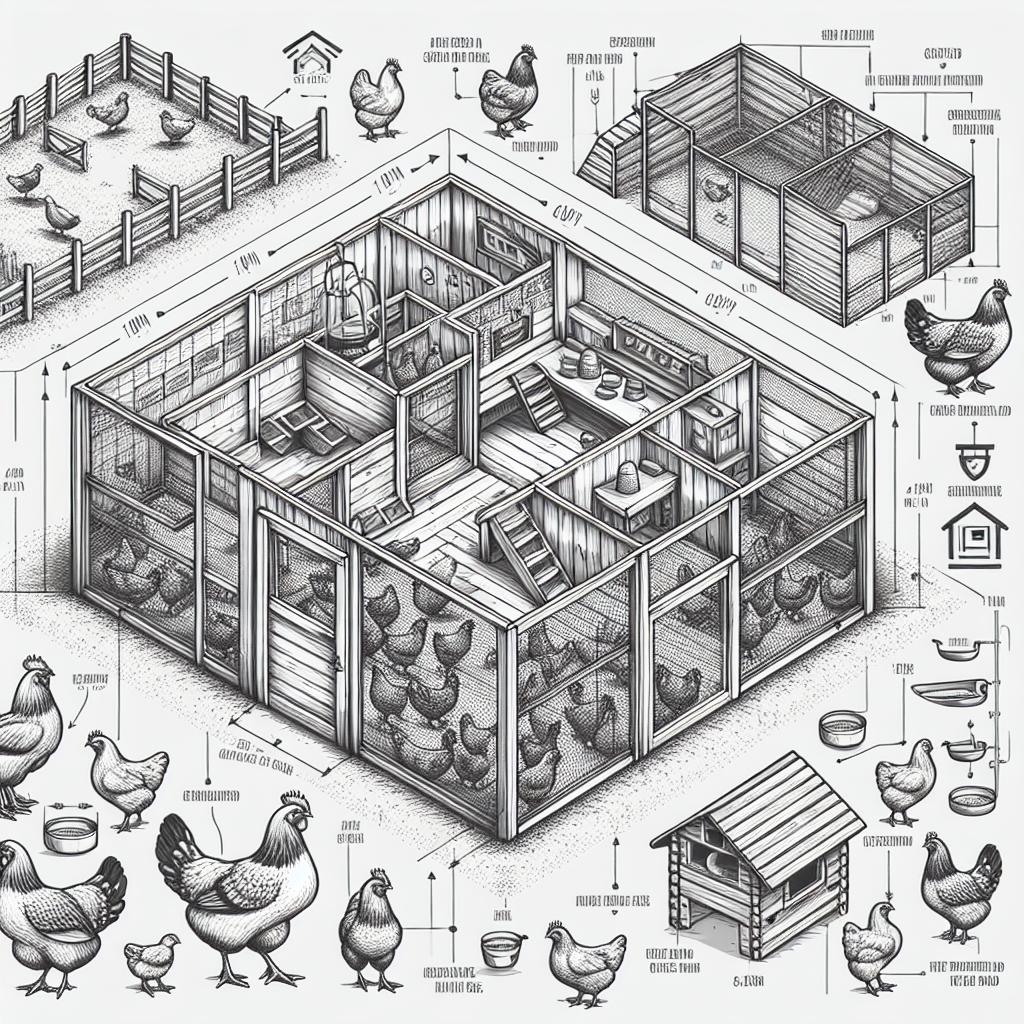If you’re a passionate poultry enthusiast and proud owner of a flock, ensuring that your coop design aligns with the space requirements for your flock size is crucial for their well-being and productivity. Designing a coop that provides enough space for your chickens to move around, roost, explore, and engage in natural behaviors is essential for their overall health and happiness. In this article, we’ll explore some practical tips and considerations to help you create the perfect coop that meets the space requirements for your flock size, ensuring a comfortable and thriving environment for your feathered friends.
Assessing Flock Size and Space Requirements
Determining the Ideal Flock Size
When it comes to raising chickens, determining the ideal flock size is an essential first step in designing your coop. The number of chickens you plan to keep will dictate the overall space requirements and coop dimensions. It is important to consider factors such as the purpose of raising chickens, available space, and your ability to care for them effectively.
To determine the ideal flock size for your coop, consider your goals and needs. Are you planning to raise chickens for eggs, meat, or simply as pets? Each purpose will require a different number of chickens. Research the specific breed you intend to keep and understand its production capabilities. This will help ensure that you have a sufficient number of chickens to meet your desired outcomes.
Understanding the Space Requirements per Chicken
To ensure the comfort and well-being of your chickens, it is crucial to understand their space requirements. Chickens need sufficient space to move around, exercise, and exhibit natural behaviors. Overcrowding can lead to stress, health issues, and reduced egg production.
As a general guideline, it is recommended to allocate a minimum of 2-4 square feet of indoor coop space per chicken. This includes space for roosting, nesting, and feeding. If you plan to keep chickens confined to the coop without access to an outdoor run, it is essential to provide ample space within the coop.
Considering Future Expansion Plans
When designing your coop, it is important to consider potential future expansion plans. If you have ambitions of growing your flock or adding additional chicken breeds, it is advisable to factor in potential expansion from the beginning. Building a coop with some extra space can save you time and money down the road.
By assessing the available space on your property and considering potential zoning restrictions or limitations, you can design a coop that allows for future growth. It is also worth considering whether your coop layout can be easily modified or expanded if needed. This foresight will ensure that your coop remains adaptable as your chicken-raising journey progresses.
Analyzing Coop Design Considerations
Determining Available Space and Constraints
Before diving into coop design, it is crucial to assess the available space and any constraints that may impact your coop’s construction. Consider the dimensions and layout of your property to determine the best location for your coop. Factors such as existing structures, trees, and proximity to neighbors should also be taken into account.
Evaluate any local regulations or HOA restrictions that may dictate the size, location, or appearance of your coop. By understanding your limitations, you can design a coop that aligns with both your needs and the constraints of your property.
Choosing Coop Type and Style
Selecting the right coop type and style is dependent on various factors, including personal preferences, the number of chickens, and the available space. Some popular coop options include traditional stationary coops, mobile coops, chicken tractors, and walk-in coops.
Consider the advantages and disadvantages of each coop type, including ease of access for cleaning, portability, predator protection, and ventilation. Additionally, think about the aesthetic appeal and how the coop will blend with your property’s overall design.
Evaluating Cooperative Features and Accessories
While the primary function of a coop is to provide shelter and security for your chickens, incorporating additional features and accessories can enhance their quality of life. Consider features such as windows for natural light, adjustable ventilation options, and access doors for ease of cleaning.
Accessories like nesting boxes, roosting bars, and feeding/watering stations should be carefully planned to ensure sufficient space for each chicken. Adequate provision of these features promotes comfort, productivity, and overall flock health.
Creating a Functional Layout
Planning for Proper Ventilation
Good ventilation is essential for the health and well-being of your flock. It helps maintain optimal air quality, controls moisture levels, and prevents the buildup of harmful gases. When designing your coop, consider incorporating windows, vents, or other mechanisms that promote air circulation.
Strategically placing windows and vents allows for adequate airflow without creating drafts. Ensure that the coop’s ventilation system can be adjusted to accommodate changing weather conditions throughout the year.
Providing Sufficient Roosting Areas
Chickens naturally seek out roosting spots to rest and sleep at night. Providing sufficient roosting areas is essential for their comfort and safety. Determine the number and length of roosting bars based on the size of your flock.
Each chicken requires a minimum of 8-12 inches of roosting bar space. Avoid overcrowding the roosting area to prevent aggression or excessive droppings accumulating in one area.
Allocating Space for Nest Boxes
If you plan to raise hens for egg production, allocating adequate space for nest boxes is crucial. Each hen needs a private and comfortable space to lay her eggs. Aim for one nest box per every 4-5 hens, ensuring each box measures at least 12×12 inches.
Consider placing the nest boxes in a dark and secluded area to create a sense of privacy and encourage natural egg-laying behavior.
Designing Ample Feeding and Watering Stations
Proper nutrition and hydration are paramount for the health and productivity of your flock. When designing your coop, ensure ample space for feeding and watering stations.
Provide enough feeders and waterers to accommodate all chickens simultaneously. Aim for at least one linear foot of feeder space per 4-5 chickens to prevent overcrowding and minimize waste. Waterers should be placed at a convenient height that allows easy access for the chickens.
Calculating Coop Dimensions
Determining the Number of Coop Sections
Dividing your coop into sections can provide various benefits, including efficient flock management and ease of maintenance. When determining the number of coop sections, consider factors such as separating different age groups or controlling access to certain areas.
Dividing the coop into sections ensures that chickens are not overcrowded and helps prevent the spread of diseases. Additionally, it allows for easier cleaning and targeted care if needed.
Calculating Floor Space per Chicken
To determine the appropriate coop dimensions, calculate the floor space required per chicken. As mentioned earlier, allocate 2-4 square feet of indoor coop space per chicken as a general guideline.
Account for additional space required for roosting bars, nest boxes, and feeding/watering stations. By multiplying the number of chickens by the recommended square footage, you can calculate the total floor space needed for your coop.
Determining Coop Height and Roost Length
Coop height plays a crucial role in chicken comfort and safety. Chickens need sufficient headroom to move around and stretch their wings. Aim for a minimum height of 6-8 feet to provide ample vertical space.
Roost length is determined by the number of chickens and the space required for each bird. Provide a minimum of 8-12 inches of roosting bar space per chicken. Calculate the total roost length by multiplying the number of chickens by the recommended per-bird space.
Calculating Nest Box and Feeder/Waterer Space
When determining the coop dimensions, it is necessary to calculate the space required for nest boxes, feeders, and waterers. As mentioned earlier, each hen needs a nest box measuring at least 12×12 inches.
Consider the size of your feeders and waterers and ensure there is sufficient space for all chickens to access them simultaneously. By accounting for these dimensions, you can design a coop layout that optimizes space utilization.
Understanding Outdoor Space Requirements
Assessing the Need for a Run or Free-ranging
Deciding whether to provide an outdoor run or allow your chickens to free-range is an important consideration. Both options have their benefits and constraints, and determining the best approach depends on your specific circumstances.
An outdoor run can provide a controlled and protected environment where chickens can safely roam and exercise. It helps prevent access to predators and reduces the risk of them damaging your garden or neighboring properties. If opting for a run, calculate the necessary outdoor space per chicken to ensure they have adequate room to move around.
Free-ranging allows chickens to explore a larger area, forage for food, and exhibit natural behaviors. However, it poses risks such as potential predator attacks and damage to gardens or property. Assess the feasibility and safety of free-ranging based on your property’s size, surroundings, and ability to manage potential risks.
Calculating Outdoor Space per Chicken
If you decide to provide an outdoor run for your chickens, it is important to calculate the space requirements. The recommended guidelines suggest allocating a minimum of 8-10 square feet of outdoor space per chicken.
This space allows for healthy exercise, ensures social interactions, and minimizes the risk of aggressive behavior. By multiplying the number of chickens by the recommended square footage, you can determine the required outdoor area.
Considering Potential Predators and Fencing
When providing outdoor space for your chickens, it is crucial to consider potential predators. Predators such as foxes, raccoons, and birds of prey can pose a threat to your flock. Assess the local wildlife in your area and design your outdoor space to prevent unauthorized access.
Secure your outdoor area with appropriate fencing that is sturdy enough to keep predators out. Ensure the fencing is buried at least 12 inches underground to prevent predators from digging under it. Regularly inspect the fencing for any potential weaknesses or gaps.
Accounting for Behavioral Needs
Designing Enrichment and Entertainment Areas
Chickens have a natural need for mental and physical stimulation. Designing enrichment and entertainment areas within your coop and outdoor space can facilitate their natural behaviors and prevent boredom.
Consider providing perches or branches for chickens to perch on, allowing them to exercise and survey their surroundings. Hanging treat dispensers or placing puzzles and toys can provide mental stimulation and encourage foraging behaviors.
Providing Dust Bathing and Foraging Facilities
Dust bathing is a crucial behavior for chickens to maintain good feather and skin health. Designate an area within the coop or outdoor space where chickens can engage in this natural behavior.
Creating space for foraging is also important. Chickens love to scratch and peck at the ground to find insects, seeds, and other edible items. Allocating a portion of your outdoor space for foraging allows them to exhibit this behavior and supplement their diet naturally.
Prioritizing Comfort and Safety
Ensuring Sufficient Natural Light
Providing sufficient natural light in your coop is essential for the overall well-being of your flock. Natural light not only aids in egg production but also contributes to the chickens’ circadian rhythm and general health.
When designing your coop, consider the placement of windows or skylights to maximize natural light. Ensure that the coop’s orientation allows for proper sunlight exposure throughout the day.
Considering Insulation and Ventilation Needs
Insulation and ventilation are critical aspects of coop design, as they regulate temperature and moisture levels. Insulation helps keep chickens comfortable during extreme weather conditions, while ventilation provides fresh air and prevents the buildup of harmful gases.
Choose appropriate insulation materials for your coop, ensuring they are safe and resistant to moisture. Install adjustable ventilation options to control airflow based on the weather conditions. Balancing insulation and ventilation ensures optimal conditions for your chickens year-round.
Implementing Proper Heating and Cooling
In regions with extreme temperature variations, it may be necessary to implement heating and cooling systems in your coop. Heating may be required during winter to prevent frostbite and ensure the chickens stay warm. Cooling systems, such as fans or misters, can help alleviate heat stress during hot summer months.
When considering these systems, prioritize safety and energy efficiency. Consult with professionals or experienced chicken keepers to determine the best heating and cooling solutions for your specific climate and coop design.
Addressing Health and Hygiene
Designing for Easy Cleaning and Maintenance
Maintaining a clean coop is crucial for the health of your flock. When designing your coop, consider features and materials that facilitate easy cleaning and maintenance.
Design removable roosting bars and nest boxes that can be easily cleaned or replaced. Use materials such as smooth surfaces and non-porous flooring to minimize the accumulation of dirt and waste. Incorporate proper drainage systems to ensure efficient waste management.
Including Quarantine and Sick Bays
Designating a specific area within your coop for quarantine and sick bays is essential for disease prevention and treatment. This isolated space allows you to separate any sick or injured chickens from the rest of the flock, minimizing the risk of spreading infections.
Ensure that the quarantine and sick bays have the necessary amenities, such as separate feeding and watering stations, to provide individualized care and monitoring.
Providing Proper Waste Management Solutions
Managing chicken waste is another important aspect of coop design. Proper waste management prevents odor buildup, reduces disease risks, and makes cleaning easier. Incorporate solutions such as removable droppings trays or litter systems that can be easily emptied and replaced.
Consider composting the chicken waste if you have a suitable outdoor area. Composting is a sustainable practice that can transform chicken droppings into nutrient-rich fertilizer for your garden.
Seeking Expert Advice and Resources
Consulting Local Agricultural Extension Services
If you are new to chicken keeping or require guidance in coop design, consulting your local agricultural extension service can provide valuable insights. These organizations offer expertise and resources on various agricultural practices, including poultry management.
Local agricultural extension services can provide details about zoning regulations, best practices for coop design, and other essential information specific to your region. They can also connect you with local experts and workshops that provide hands-on training and support.
Joining Online Forums or Community Groups
Online forums and community groups dedicated to chicken keeping can be a treasure trove of knowledge and advice. Engaging with fellow chicken enthusiasts allows you to learn from their experiences and gain valuable insights into coop design considerations.
Joining these communities provides an opportunity to ask questions, share ideas, and connect with like-minded individuals who share a passion for raising chickens. Utilize these platforms to expand your knowledge and receive practical tips from experienced chicken keepers.
Utilizing Coop Design Apps and Software
Advancements in technology have introduced various coop design apps and software programs that can assist in creating functional and efficient coop layouts. These digital tools provide the flexibility to visualize and customize coop designs based on your specific requirements.
Coop design apps and software features may include 3D modeling, measurement calculations, and material selection options. Utilize these resources to experiment with different coop layouts and configurations before finalizing your design.
Considering Budget and Material Constraints
Setting a Realistic Budget
When embarking on a coop design project, it is essential to determine your budgetary constraints. Assess the funds available for the coop construction, taking into account material costs, labor, and any additional features or accessories.
Setting a realistic budget helps guide your decision-making process and ensures that you prioritize essential elements of the coop design. Research the costs of materials, gather multiple quotes, and consider DIY options if you have the necessary skills and resources.
Choosing Suitable Building Materials
Selecting suitable building materials is important for the durability and functionality of your coop. Consider factors such as weather conditions, predator risks, and your long-term maintenance plans.
Commonly used materials for coop construction include wood, metal, and plastic. Each material has its advantages and disadvantages, so it is important to research and choose the option that best fits your needs and budget. Prioritize materials that are safe, non-toxic, and resistant to weather and decay.
By thoroughly considering your budget and material constraints, you can design a coop that meets your needs without compromising on the quality and longevity of the structure.
In conclusion, designing a coop that aligns with the space requirements for your flock is a crucial step in ensuring the well-being and productivity of your chickens. By assessing factors such as flock size, space requirements, coop design considerations, and outdoor space requirements, you can create a functional and comfortable environment for your feathered friends. Remember to seek expert advice, utilize available resources, and prioritize the safety and health of your flock throughout the design process. With careful planning and consideration, your coop will provide a happy and healthy home for your chickens for years to come.




